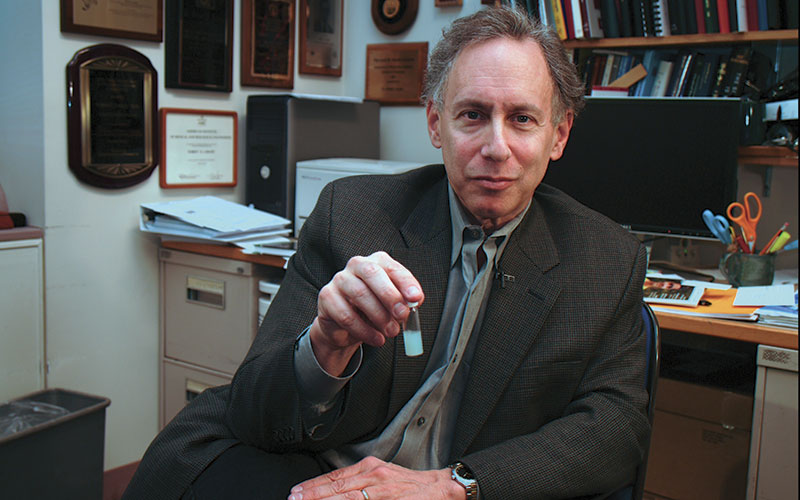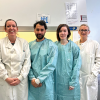Professor Robert Langer, Institute Professor at the Massachusetts Institute of Technology (MIT) and a scientist, entrepreneur and inventor, discusses his research, advances in cancer treatment, biomaterials and slow-release medicines.

Cancer is still a major killer disease – the second leading cause of death globally and responsible for an estimated 9.6 million deaths in 2018 (globally, around 1 in 6 deaths). What do you think the major breakthroughs are going to be in this area?
I think that some of the developments in cancer treatment are very exciting. I would say some of the things that we might see in the near future are more personalised cancer vaccines, more immunotherapy-based therapies and more cellular-based therapies, all of which are basically harnessing the immune system in different ways to more effectively treat the disease.
I think we’ll see many more personalised cancer vaccines, in particular using messenger RNA (mRNA), which is a form of treatment that uses the patient’s own cells to fight diseases and allows the development of vaccines against a person’s particular cancer, rather than a one-size-fits all approach. So, they are extremely personal because you’re really looking at an individual person’s cancer to help design how you’re going to make a personalised antibody. I hope this will hugely impact the numbers of people dying from the disease.
In which other areas do you think the big strides will be made in treatments over the next decade?
I think we’ll develop much more effective treatments for rare diseases, again through mRNA therapies and genetic therapies. We just saw approval of an RNA drug for spinal muscular atrophy (see p.10), for example, a rare neuromuscular disorder where symptoms include progressive muscle wasting, resulting in death at a young age. That was a huge step. I think you will see other RNA drugs being developed and approved for other rare diseases – I think methylmalonic acidemia (an inherited disorder in which the body cannot break down certain proteins and fats, where the long-term complications can include serious problems, such as chronic kidney disease) and phenylketonuria an inborn error of metabolism that results in decreased metabolism of the amino acid phenylalanine, which can lead to intellectual disability, seizures and mental disorders) are probably two
of the next ones we’ll see mRNA treatments being developed.
Speaking of inherited disorders, I’m sure you saw the recent story of the Chinese scientist who claimed he had made the world’s first genetically edited babies, altering their DNA as embryos to prevent them contracting HIV. This caused huge controversy, of course, but do you think we will see a time when it may be more accepted to edit unborn babies’ genes to prevent them developing diseases?
Well, we saw the reaction of the scientific community to these claims – which have not been corroborated – certainly gene editing of live embryos is a long way off being accepted at the moment. Intervention into unborn children is very controversial. Many countries, of course, have laws that prevent the use of gene editing too.
I think one day – perhaps even in the next few decades – we will see gene editing, but a whole raft of safeguards and measures, quite rightly, will be required before it will be allowed, depending on the type of treatment.
Your polymer research has already led to the design of new kind of biomaterials that can be used as tissues. We can already use human cells to grow skin, cartilage, noses, ears, heart valves, bladders and so on. How far away are we from the next steps in this area, such as growing the likes of the liver, the kidney and the pancreas?
In terms of growing pancreases, I think, that’s actually going quite well. We’ve published a number of papers and hopefully that will enter clinical trials in two years. Liver is already in clinical trials but that, and growing kidneys, are further away.
Life expectancy is increasing in the Western world. Do you think we’re reaching the limit of the extension in human lifespans or do you think we’ll have treatments that will mean we live significantly longer in future? For example, Michio Kaku, the theoretical physicist, has said we’ll be laying the foundations for immortality by 2050 and we’ll understand how to repair biological damage and rather than allow the organs we’re born with to become old and decrepit, we’ll be able to replace them.
That’s a good question. I think that we will develop treatments than mean we do live longer, but I don’t think it will be that much longer. I think the numbers will go up, but I don’t know that they’ll go up extraordinarily. Longevity of life is one thing, but there’s also quality of life to think about, as well as longevity – what happens to our brains and so forth is vital for ensuring we live a high-quality life and while we may someday be able to replace kidneys and livers, for example, we’re a long way off being able to do that for organs like the brain.
Treatments these days are hugely innovative and complex and more successful, but this often means they’re expensive. Are you worried about whether everyone who could benefit from such treatments will be able to benefit from it, such as those in poorer countries?
Well, that’s an area I’m working on with The Gates Foundation. It’s about making treatments more accessible too. For example, in the case of polio which, although we’re now seeing fewer and fewer cases, is still prevalent in remote areas of the world like Pakistan because of the difficulty in physically reaching these areas to administer the multiple injections that are needed to protect against the disease. The Gates Foundation is funding research, led by us at MIT, into a single injection vaccine that slowly releases the vaccine over time, to address this problem. Researchers at MIT are also working on applying this approach to create stable, single-injection vaccines that might someday be used for other viruses, such as Ebola and HIV – steps such as those would have a staggering impact in the developing world of course.
On the subject of slow-release medicines, you won the Millennium Technology Prize (see box) in 2008 for your research into more effective controlled drug release and nanotechnology. How far further will we be able to go in terms of making things smaller? Is there a limit?
I think you’ll be able to make things smaller and smaller, I’m not worried about that. For example, our lab at MIT, along with other researchers, devised a miniaturised device, consisting of several tubes contained within a needle about as thin as a human hair, that can deliver tiny quantities of medicine to brain regions as small as 1 cubic millimetre.
This type of targeted dosing could make it possible to treat diseases that affect very specific brain circuits, without interfering with the normal function of the rest of the brain. This microfabricated device could have tremendous impact in understanding brain diseases, as well as providing new ways of delivering biopharmaceuticals and performing biosensing in the brain.
Drugs used to treat brain disorders often interact with brain chemicals called neurotransmitters, or the cell receptors that interact with neurotransmitters. Examples include l-dopa, a dopamine precursor used to treat Parkinson’s disease, and Prozac, used to boost serotonin levels in patients with depression. However, these drugs can have side effects because they act throughout the brain. One of the problems with central nervous system drugs is that they’re not specific, and if you’re taking them orally, they go everywhere. The only way we can limit the exposure is to just deliver to a cubic millimetre of the brain, and in order to do that, you have to have extremely small cannulas.
This is one example where getting smaller and smaller works. But the question you have to ask in any case is whether that is necessarily a good thing? In other words, for some treatments, there’s an advantage to making them a little bit bigger because you can get more of a payload in there. When you make it super small, your payloads are going to be a lot lower.
MIT has been at the forefront of some ground-breaking research in so many areas. What’s the secret of its success?
I think it’s just been outstanding people, not me, but lots of other very, very bright students and professors.
You’ve said you believe that a greater effort should be devoted to forming new generations of scientists by attracting good science teachers at the high school level, and by making science teaching a national priority. Do you believe prizes like the Millennium Technology Prize have a role in that in terms of celebrating science and technology and raising its profile? And what difference did winning the Prize mean for you?
In terms of good science teachers and making science a national priority? Absolutely. I think prizes like Millennium Technology Prize help create role models and I think that that’s terrific.
In terms of making a difference to me personally, winning awards like the Millennium Technology Prize makes everybody in our lab, and everybody doing biomedical engineering, feel like it was a even more important than it was before. So, I also do feel it encourages people to think positively about the fields that we work in. I think that’s good too.
The Millennium Technology Prize
The Millennium Technology Prize is a one million euro award – one of the world’s largest technology prizes. It is awarded once every two years with the aim of promoting technological research.
The prize celebrates innovations that have a favourable and sustainable impact on quality of life and well-being of people. The innovations must also have been applied in practice and have stimulated further research and development.
Nominations for the 2020 Millennium Technology Prize are now open and are accepted until 31 July 2019.
For more information, visit millenniumprize.fi




